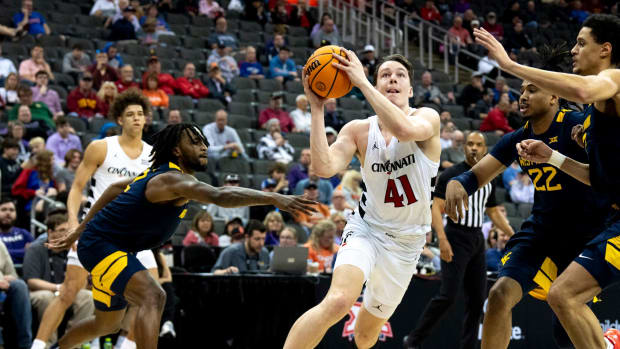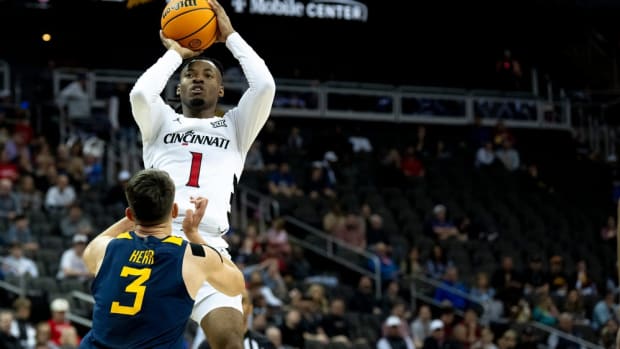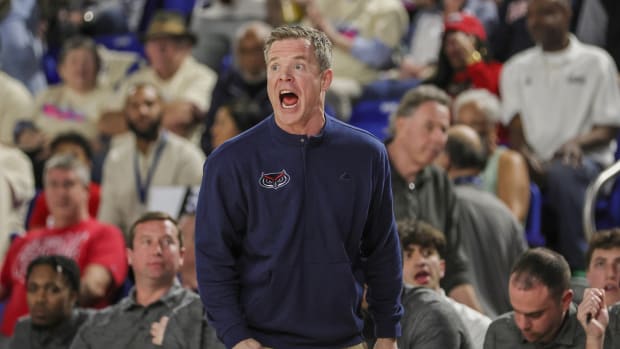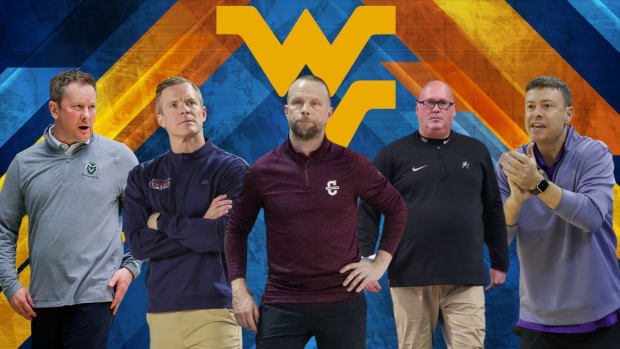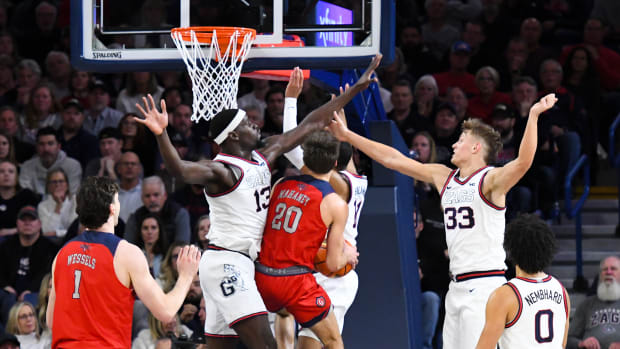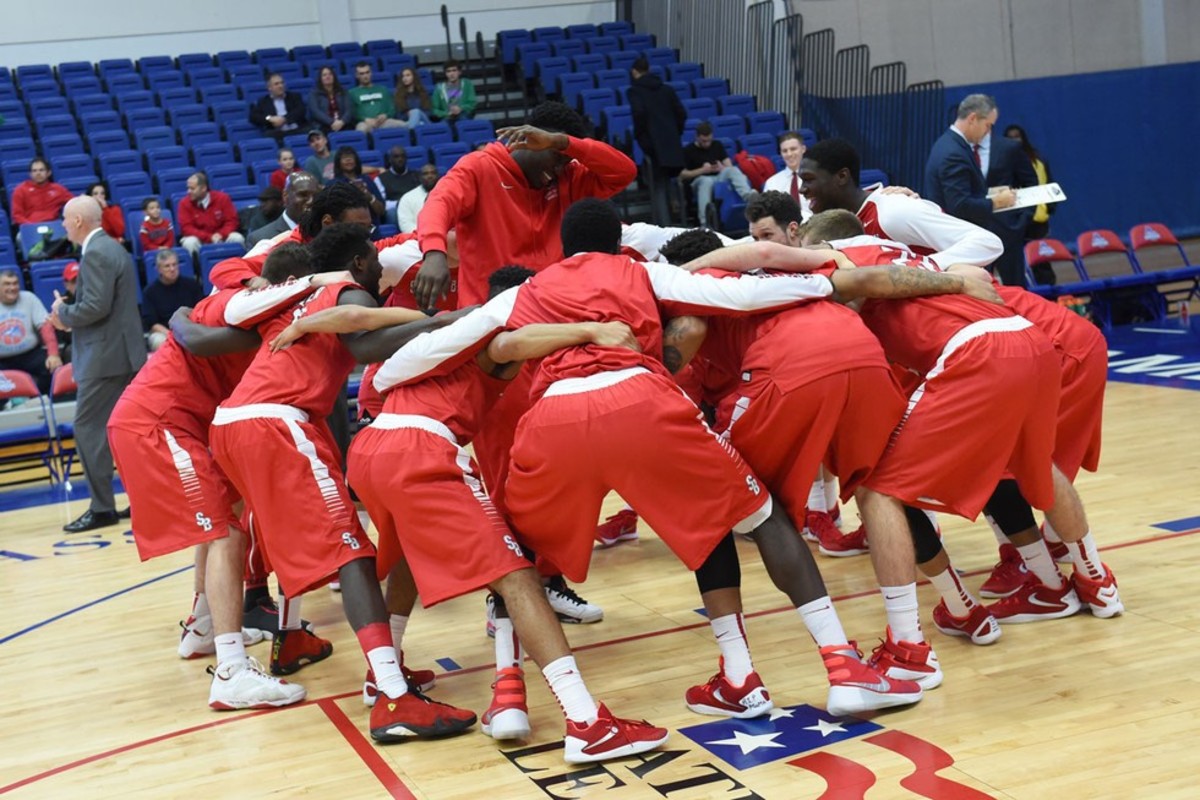
Dancing for the first time: What a March Madness berth in 2016 means to the Stony Brook basketball program
[video: 13724949]
STONY BROOK, N.Y. — He was still wearing the net. On Sunday, when Jameel Warney strolled down a red carpet lined by Stony Brook cheerleaders and walked onto the court where the Seawolves had clinched their first NCAA tournament berth, the nylon remains of the most significant victory in program history were draped over his shoulders. With AC/DC's "Thunderstruck" ringing throughout the 4,000-seat venue, Warney clutched the America East regular-season men's basketball championship trophy with two hands and gazed ahead. Then the 6' 8", 260-pound senior center and his teammates filed into a row of charcoal-colored seats along the sideline and prepared to find out their first-round opponent.
Other players tied pieces of the net around the straps of black baseball caps turned backward, but their shares of the spoils of victory were minor by comparison; an uninformed observer might have mistaken Warney's adornment for an unfashionable scarf. A day earlier, he had delivered one of the best individual performances of the season, a 43-point, 10-rebound, four-block masterpiece that lifted Stony Brook over Vermont 80–74 in the league title game. But when fans stormed the court as soon as the clock ran out on the Seawolves' win, they weren't merely celebrating an important on-court breakthrough.
They were rejoicing in a moment that would have seemed unfathomable not so long ago.
*****
Icon Sportswire via AP Images
The State University of New York system (SUNY), of which Stony Brook is a member, did not offer athletic scholarships until 1986, and the program didn't play its first season of Division I basketball until '99. In 2005, less than a month after the Seawolves hired their current coach, Steve Pikiell, Stony Brook was placed on three years' probation by the NCAA for a lack of institutional control. As recently as '09, amid hundreds of millions of dollars in budget cuts, there was skepticism over the viability of SUNY schools sustaining sports in the NCAA's top division. Reach the tourney? Stony Brook simply needed to keep its program afloat.
But Pikiell did much more than that. He weathered the NCAA penalties. He donated $25,000 to Stony Brook basketball. He led his team to six seasons with at least 22 wins between 2009-10 and 2015-16, and in '07 he plucked a two-star power forward out of a Catholic school in northern New Jersey and developed him into one of the premier big men in the nation. Yet until this season, Pikiell hadn't been able to push Stony Brook across the finish line. It took the Seawolves five trips to the America East championship game in six years—including a one-point loss to Albany on a buzzer-beating three-pointer in '15—to finally earn a bid.
"It was just sheer elation," Stony Brook athletic director Shawn Heilbron says of winning the league title. "When that final buzzer sounded, all I could think about was how coach Pikiell, our team, this community have wanted this for so long. And to finally know that it was real was just—it was very emotional."
Adds Warney of his thoughts at the final buzzer on March 12: "Finally, finally we won, finally. Finally I did what I wanted to do when I got here—just win a championship, and now we're going to play on Thursday."
It has become customary to link athletic success on college campuses to an increase in applications and donations, a theory referred to as the "Flutie Effect." (Applications to Boston College reportedly surged after Doug Flutie completed his Hail Mary pass to beat Miami 47–45 in 1984.) Though studies have cast doubt on the validity of this theory—Cornell economics professor Robert H. Frank wrote in a 2004 paper for the Knight Commission on Intercollegiate Athletics that "the most forceful conclusion that can be drawn about the indirect effects of athletic success is that they are small at best when viewed from the perspective of any individual institution"—Heilbron described the "huge" potential impact of Stony Brook making the tourney.
"It's a fact," Heilbron says. "There's clearly a marketing benefit to going to the NCAA tournament. For Stony Brook to get there, we expect to see that, we expect to see the university benefit from it. That's something we really see as our responsibility to the university—is to serve as a marketing platform and represent our school the right way."
The Seawolves moved from a 1,700-seat gym on campus to their new digs (Island Federal Credit Union Arena) in 2014, and average home attendance increased from 1,192 in 2000-01 to 2,943 in 2014-15, according to the athletic department. With its first-round game just days away, Stony Brook will have a chance to boost its visibility even more.
Says Sam Di Canio, a 58-year-old graduate of the school: "The wait was worthwhile."
*****
Mitchell Layton/Getty Images
An unmistakable air of gloom hung over this 1,039-acre campus on the northern coast of Long Island on Sunday afternoon. Light gray skies, leafless trees and mostly empty walkways (Stony Brook's spring break was set to begin on Monday) created the sort of setting you might find in the opening scene of a horror film. An eerie silence was interrupted only by the steady hum of a longboarder cruising down the middle of the road past the student union. A man wearing a red Seawolves shirt and a long-sleeve gray layer underneath sat alone at the top of the steps leading to the arena. If a party was about to go down, it was hard to notice.
Inside, the overriding sentiment was decidedly brighter. Yet as Stony Brook's team awaited the start of the selection show, anxiety prevailed.
Who would the Seawolves meet in the first round? Warney kept his eyes fixed on one of the big screens in the arena while occasionally fiddling with his phone. Each time a No. 4 or 5 seed was slotted in the bracket, players and fans perked up, anticipating Stony Brook's placement. A loud "ahhh" emanated from the stands when UNC-Wilmington was matched up with No. 4 seed Duke instead of the Seawolves. As it turned out, Stony Brook would draw a program of similar stature.
GARDNER: Jameel Warney may be college basketball's MVP
By the time Kentucky was revealed as the No. 4 seed in the East region, the bracket had already leaked and made the rounds on social media. That deflated the raw euphoria of the moment, but the revelation elicited a loud roar from the crowd nonetheless. "A lot of teams put their uniforms away," Pikiell said afterward. "We get to play—and we get to play one of the best programs in the country."
In the days since it beat Vermont, Stony Brook has been floated as a possible Cinderella. However, the Seawolves will have to face a foe that was arguably under-seeded relative to its talent level. In Kentucky, they will take on perhaps the best offensive outfit in the country. Stony Brook will counter with a stingy defense and a strong senior trio: Warney, guard Carson Puriefoy and forward Rayshaun McGrew.
For Warney, who averages 19.8 points and 10.7 rebounds, the game will also serve as a prime showcase for NBA scouts. He'll try to outplay projected lottery pick Skal Labissiere and athletic shot-blocker Marcus Lee. Asked about the prospect of facing the talented Wildcats, Warney smiled. "Do I look excited?"
Whether or not the Seawolves advance, this much is clear about Thursday's game against Kentucky: They earned their place there.


